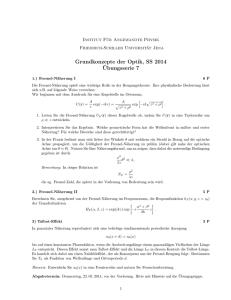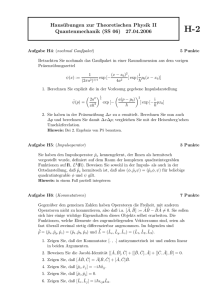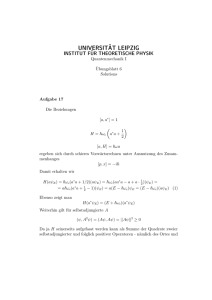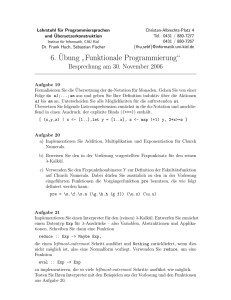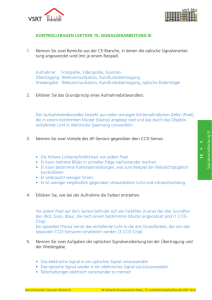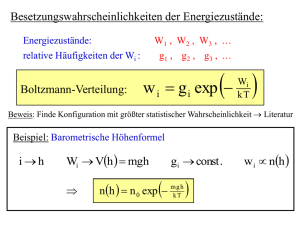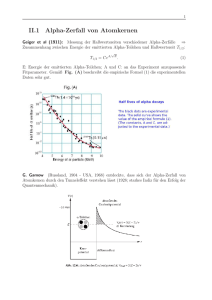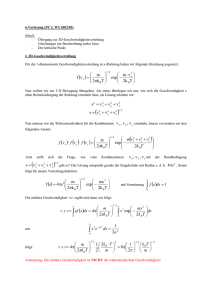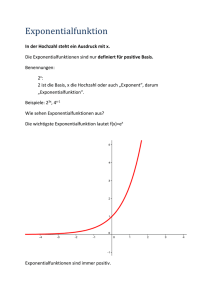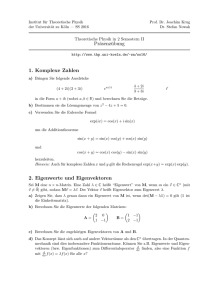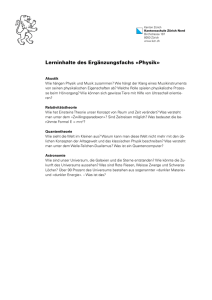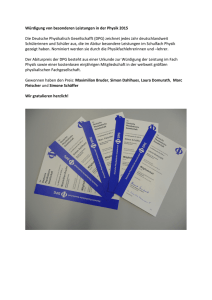I t
Werbung
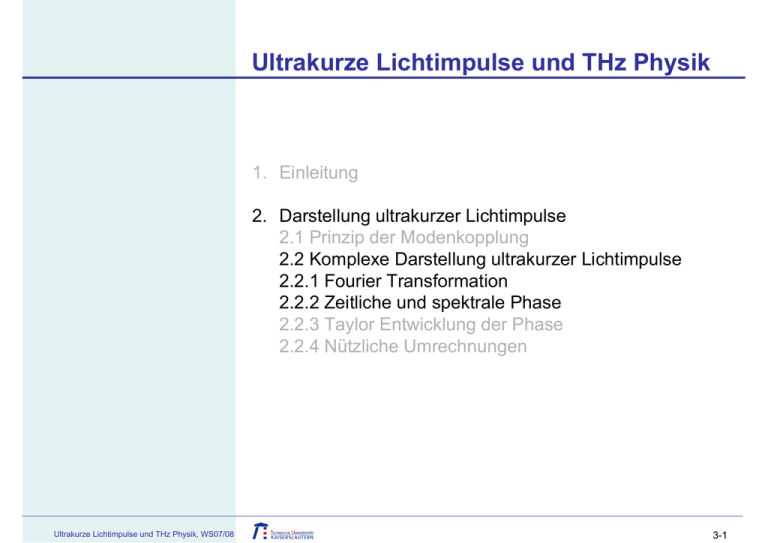
Ultrakurze Lichtimpulse und THz Physik
1. Einleitung
2. Darstellung ultrakurzer Lichtimpulse
2.1 Prinzip der Modenkopplung
2.2 Komplexe Darstellung ultrakurzer Lichtimpulse
2.2.1 Fourier Transformation
2.2.2 Zeitliche und spektrale Phase
2.2.3 Taylor Entwicklung der Phase
2.2.4 Nützliche Umrechnungen
Ultrakurze Lichtimpulse und THz Physik, WS07/08
3-1
2. Darstellung ultrakurzer Lichtimpulse
2.2 Komplexe Darstellung ultrakurzer Lichtimpulse
Ultrakurze Lichtimpulse und THz Physik, WS07/08
3-2
2.2.1 Fouriertransformation
∞
1
E (t ) =
⋅ ∫ dω ⋅ E (ω ) ⋅ eiωt
2π −∞
∞
Fouriertransformation:
E (ω ) = ∫ dt ⋅ E (t ) ⋅ e −iωt
−∞
Zusammenhang zwischen zeitabhängiger und
frequenzabhängiger Feldstärke.
Beschreibung im Zeitbild und Frequenzbild sind äquivalent.
Spektrale Amplitude E(ω) läßt sich beschreiben durch eine
spektrale Amplitude a(ω) und eine spektrale Phase φ(ω):
E (ω ) = a (ω ) ⋅ e iφ (ω )
Ultrakurze Lichtimpulse und THz Physik, WS07/08
3-3
Frequenzbild - Zeitbild
Beschreibung im
Zeitbild:
Beschreibung im
Frequenzbild:
- Halbwertsbreite Δt
- Chirp Φ(t) (Phasenmodulation der Trägerfrequenz)
- spektrale Breite Δν
- spektrale Phase φ(ω)
PulsBandbreiteprodukt:
Δν ⋅ Δτ ≥ const.
Konstante ist abhängig von der Pulsform!
Ultrakurze Lichtimpulse und THz Physik, WS07/08
3-4
Zeit-Bandbreite-Produkt ZBT
ZBP etc. für
verschiedene
Pulsformen:
Ultrakurze Lichtimpulse und THz Physik, WS07/08
3-5
Sech2 Pulsform
Wichtige Pulsform für passiv modengekoppelte
Lasersysteme
Lösung der nichtlinearen Wellengleichung
Solitonen
Ultrakurze Lichtimpulse und THz Physik, WS07/08
3-6
Zeit-Bandbreite-Produkt ZBT
Bedeutung des ZBT:
1. Fall:
Δτ ⋅ Δν = c
2. Fall:
Δτ ⋅ Δν > c
Ultrakurze Lichtimpulse und THz Physik, WS07/08
Analogie zur Heisenbergschen Unschärferelation
Puls heißt „bandbreitenbegrenzt“, d.h. alle enthaltenen
Frequenzkomponenten tragen optimal zum
kürztestmöglichen Puls bei.
Ein Gaußscher Laserstrahl würde in Analogie
als „beugungsbegrenzt“ bezeichnet.
Puls heißt „phasenmoduliert“ (engl. chirped), d.h. ein
Anteil der enthaltenen Frequenzkomponenten trägt zu
einer Phasenmodulation des elektrischen Trägerfeldes
bei. Der Puls ist also bzgl. seiner Bandbreite nicht
optimal kurz !
3-7
2.2.2 Zeitliche und spektrale Phase
Electric field E (t)
Ein ultrakurzer Impuls
hat eine zeitabhängige
Intensität und Phase
Komplexe Darstellung im Zeitbild:
Vernachlässigung der räumlichen Abhängigkeit,
ergibt für das elektrische Feld:
X (t ) =
I (t )
Intensität
1
2
I (t ) exp{i [ω0t − φ (t )]} + c.c.
Trägerfrequenz
Phase
A sharply peaked function for the intensity yields an
ultrashort pulse.
Time [fs]
Die Phase bestimmt die “Farbentwicklung” des Pulses als
Funktion der Zeit.
Ultrakurze Lichtimpulse und THz Physik, WS07/08
3-8
Reale und komplexe Pulsamplitude
Vernachlässigung von ½, dem c.c. und dem
Exponentialfaktor mit der Trägerfrequenz ergibt die
komplexe Amplitude, E(t), des Pulses:
Electric field E (t)
E (t ) = I (t ) exp{−iφ (t )}
I (t )
Damit entfällt der schnell oszillierende Term des
elektrischen Feldes des Pulses.
E(t) ist eine komplexe Größe, mit der sich einfacher
rechnen lässt.
Time [fs]
Ultrakurze Lichtimpulse und THz Physik, WS07/08
I (t)
wird oft die reale Amplitude, A(t), des Pulses
genannt
3-9
Intensität und Phase im Zeitbild
Zusammenhang zwischen elektrischem Feld,
Intensität und Phase des elektrischen Pulses
Intensität:
Phase:
I(t) = |E(t)|2
⎧ Im[ E (t )] ⎫
⎬
Re[
E
(
t
)]
⎩
⎭
φ (t ) = arctan ⎨
Im
√ I(
ti )
Analog,
E(ti)
φ(t) = Im{ ln[E(t)] }
φ(ti)
Re
Ultrakurze Lichtimpulse und THz Physik, WS07/08
3-10
Frequenzbild
Für die Beschreibung und Behandlung ultrakurzer
Lichtimpulse ist die Fouriertransformation unerlässlich
∞
X% (ω ) =
∫
X (t ) =
1
2π
−∞
X (t ) exp(−iω t ) dt
∫
∞
−∞
X% (ω ) exp(iω t ) d ω
Komplexe Fouriertransformationen werden hier immer
nur auf den Real- oder Imaginärteil des elektrischen
Pulsfeldes angewandt (wenn nicht anders angegeben).
Ultrakurze Lichtimpulse und THz Physik, WS07/08
3-11
Elektrisches Feld im Frequenzbild
The frequency-domain equivalents of the intensity and
phase are the spectrum and spectral phase.
Fourier-transforming the pulse electric field:
X (t ) =
I (t ) exp{i [ω0t − φ (t )]} + c.c.
1
2
Note that φ and ϕ are different!
yields:
X% (ω ) =
1
2
S (ω − ω0 ) exp{−i [ϕ (ω − ω0 )]} +
1
2
S (ω + ω0 ) exp{−i [ϕ (ω + ω0 )]}
The frequency-domain electric field has positive- and
negative-frequency components.
Ultrakurze Lichtimpulse und THz Physik, WS07/08
3-12
Elektrisches Feld im Frequenzbild
Since the negative-frequency component contains the
same information as the positive-frequency
component, we usually neglect it.
We also center the pulse on its actual frequency, not
zero. Thus, the most commonly used complex
frequency-domain pulse field is:
X% (ω ) ≡
S (ω ) exp{−i ϕ (ω )}
Thus, the frequency-domain electric field also has
an intensity and phase.
S is the spectrum, and ϕ is the spectral phase.
Ultrakurze Lichtimpulse und THz Physik, WS07/08
3-13
Die Fourier Transformierte von cos(ω0 t)
∞
cos(ω0t)
0
F
{cos(ω0t )}
=
∫ cos(ω t ) exp(−i ω t ) dt
0
−∞
t
=
=
1
2
1
2
∞
∫ [exp(i ω t ) + exp(−i ω t )] exp(−i ω t ) dt
0
0
−∞
∞
∫
exp(−i [ω − ω0 ] t ) dt
+
−∞
1
2
∞
∫ exp(−i [ω + ω ]t ) dt
0
−∞
F {cos( ω 0 t )}
−ω0
0 +ω0
ω
Ultrakurze Lichtimpulse und THz Physik, WS07/08
= π δ (ω − ω0 ) + π δ (ω + ω0 )
3-14
The Fourier Transformierte von E(t)cos(ω0 t)
F
{E (t ) cos(ω0t )}
∞
∫ E (t ) cos(ω t ) exp(−i ω t ) dt
=
0
−∞
=
=
F
Beispiel:
E(t) = exp(-t2)
Ultrakurze Lichtimpulse und THz Physik, WS07/08
1
2
1
2
∞
∫ E (t ) ⎡⎣exp(i ω t ) + exp(−i ω t )⎤⎦ exp(−i ω t ) dt
0
0
−∞
∞
∫
E (t ) exp(−i [ω − ω0 ] t ) dt +
−∞
{E (t ) cos(ω0t )}
=
1
2
1 %
E (ω − ω0 ) +
2
E (t ) cos(ω0t )
F
t
∞
∫ E (t ) exp(−i [ω + ω ]t ) dt
0
−∞
1 %
E (ω + ω0 )
2
{E (t ) cos(ω0t )}
-ω0
0
ω0
ω
3-15
Elektrisches Feld im Frequenzbild
Achtung:
Zeitbild:
mitbewegtes
Koordinatensystem,
Pulsmaximum: t = 0
Schnell oszillierende
Terme unterdrückt!
Fourier Transformation der spektralen Amplitude E (t) oder
~
des Gesamtfeldes E (t ) ergibt unterschiedliche Funktionen.
~
E (ω )
~
E (ω )
E (ω − ω0 )
Frequenzbild:
Spektrum zentriert
um ω0,
Nullpunkt unterdrückt!
Üblicherweise genutzte Komponente.
Ultrakurze Lichtimpulse und THz Physik, WS07/08
3-16
Elektrisches Feld im Frequenzbild
Spektrum und
spektrale Phase:
The spectrum and spectral phase are obtained from the
frequency-domain field the same way as the intensity and
phase are from the time-domain electric field.
2
S (ω ) = X% (ω )
⎧ Im[X% (ω )] ⎫
ϕ (ω ) = − arctan ⎨
⎬
%
X
Re[
(
ω
)]
⎩
⎭
oder
ϕ (ω ) = − Im {ln[X% (ω )]}
Ultrakurze Lichtimpulse und THz Physik, WS07/08
3-17
Beispiel: Gauß-Puls
For almost all calculations, a good first
approximation for any ultrashort pulse is the
Gaussian pulse (with zero phase).
Intensität:
2
[
exp[−2.76(t / τ
]
) ]
I(t) = E0 exp −4 ln 2 (t / τ FWHM )2
= E0
2
2
FWHM
where τFWHM is the intensity full-width-half-maximum.
Amplitude:
E (t ) = E0 exp ⎡⎣ −(t / τ HW 1/ e ) 2 ⎤⎦
= E0 exp ⎡⎣ −2 ln 2 (t / τ FWHM ) 2 ⎤⎦
= E0 exp ⎡⎣ −1.38(t / τ FWHM ) 2 ⎤⎦
Für t =
Ultrakurze Lichtimpulse und THz Physik, WS07/08
2 ⋅τ FWHM ist E (t = 2 ⋅τ FWHM ) = E0
2
3-18
Beispiel: Gauß-Puls
Halbwertsbreiten
für Intensität und
elektrisches Feld
The phase of this pulse is constant, φ(t) = 0, and is not
plotted.
The intensity of a Gaussian pulse is √2 shorter than its
real amplitude. This factor varies from pulse shape to
pulse shape.
Ultrakurze Lichtimpulse und THz Physik, WS07/08
3-19
Beispiel: Gauß-Puls
Intensität und
Phase eines GaußPulses:
The Gaussian is real, so its phase is zero.
Time domain:
Fouriertransformation
eines Gauß-Pulses ist
wieder ein Gauß-Puls
Frequency domain:
So the spectral phase is zero, too.
Ultrakurze Lichtimpulse und THz Physik, WS07/08
3-20
Instantane Frequenz
The temporal phase, φ(t), contains frequency-vs.-time
information. The pulse instantaneous angular frequency,
ωinst(t), is defined as:
Instantane Frequenz:
ωinst (t ) ≡ ω 0 −
dφ
dt
This is easy to see. At some time, t, consider the total
phase of the wave. Call this quantity φ0:
φ0 = ω 0t − φ (t )
Exactly one period, T, later, the total phase will (by
definition) increase to φ0 + 2π:
φ0 + 2π = ω 0 [t + T ] − φ (t + T )
where φ(t+T) is the slowly varying phase at the time,
t+T. Subtracting these two equations:
2π = ω 0T − [φ (t + T ) − φ (t )]
Ultrakurze Lichtimpulse und THz Physik, WS07/08
3-21
Instantane Frequenz
Dividing by T and recognizing that 2π/T is a frequency,
call it ωinst(t):
ωinst(t) = 2π/T = ω0 – [φ(t+T) – φ(t)] / T
But T is small, so [φ(t+T)–φ(t)] /T is the derivative, dφ /dt.
So we’re done!
Usually, however, we’ll think in terms of the
instantaneous frequency, νinst(t), so we’ll need to divide
by 2π:
νinst(t) = ν0 – [dφ /dt] / 2π
While the instantaneous frequency isn’t always a rigorous
quantity, it’s fine for ultrashort pulses, which have broad
bandwidths.
Ultrakurze Lichtimpulse und THz Physik, WS07/08
3-22
